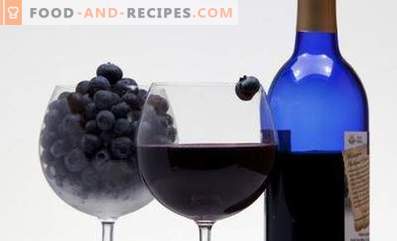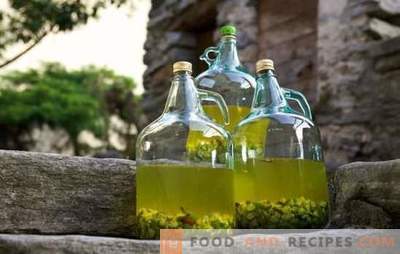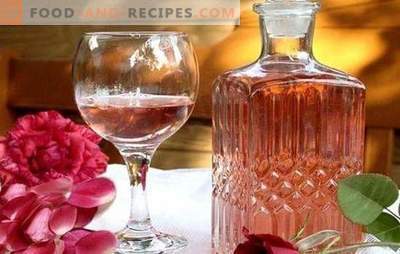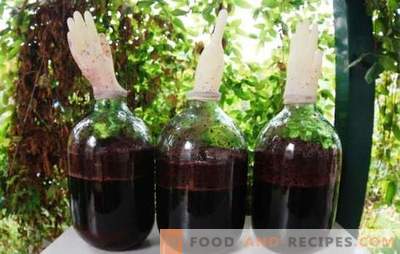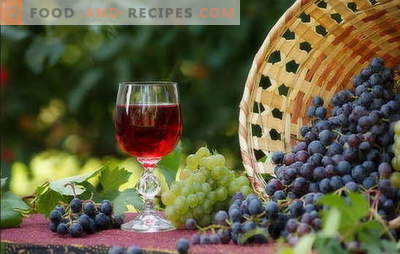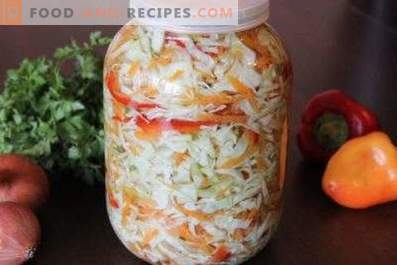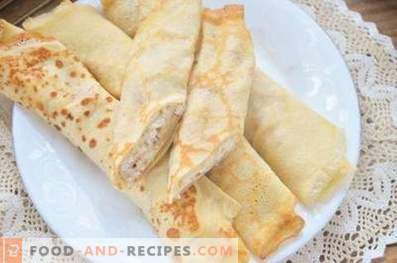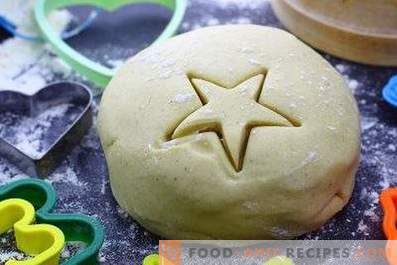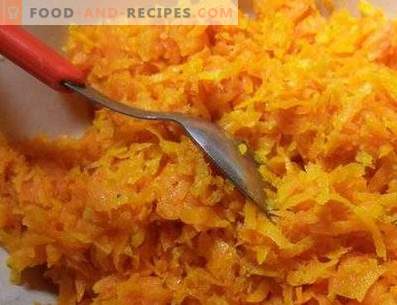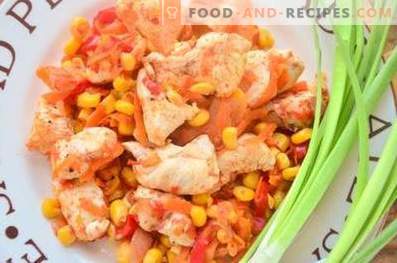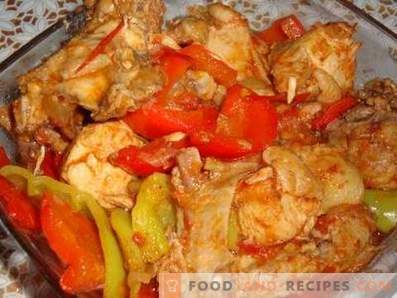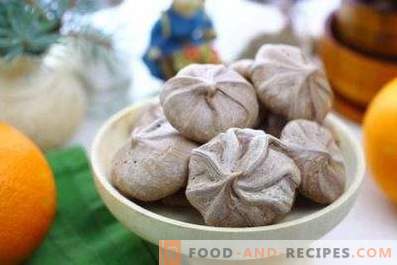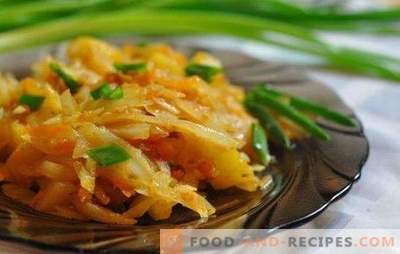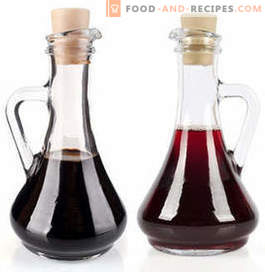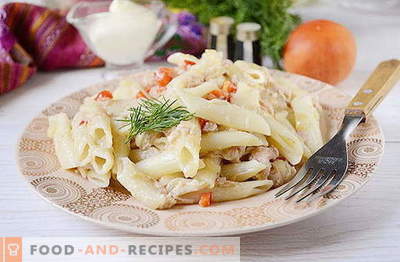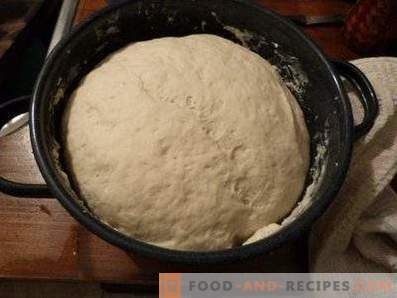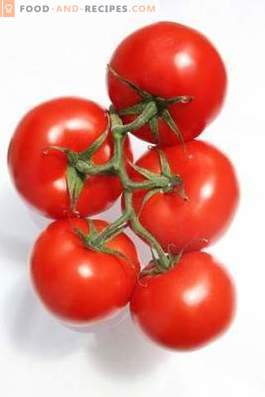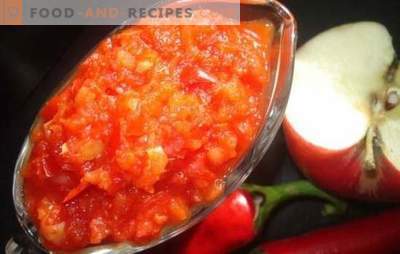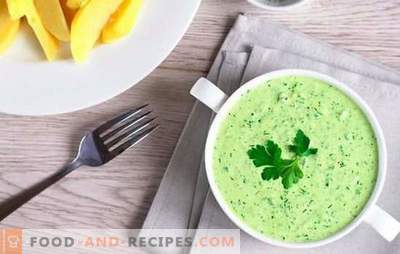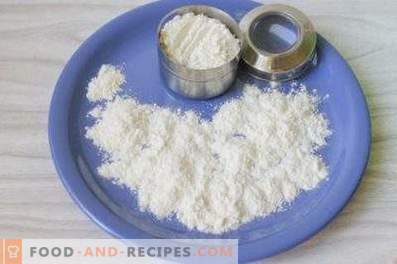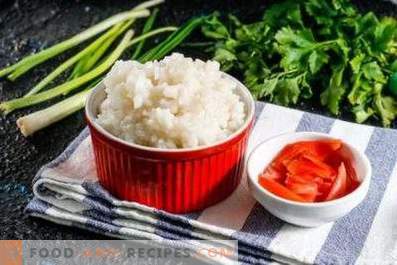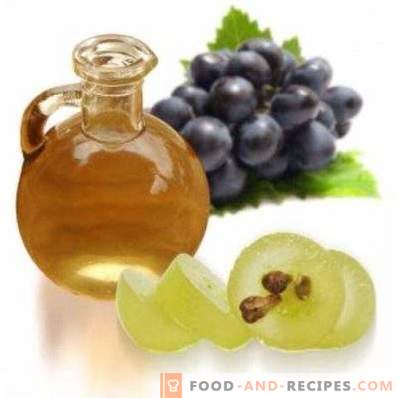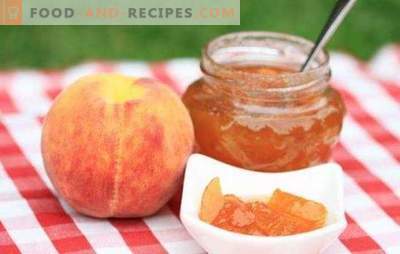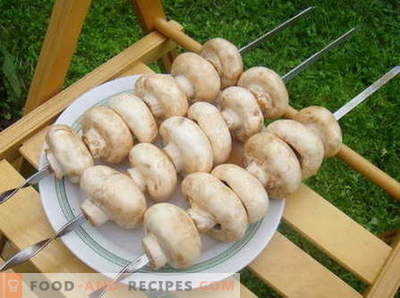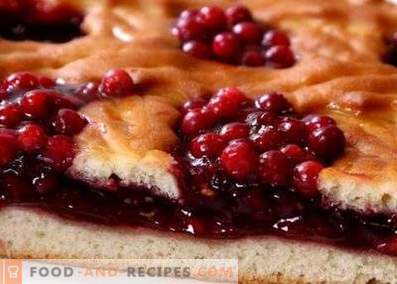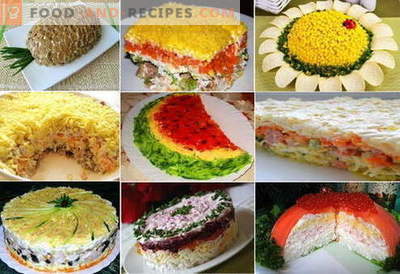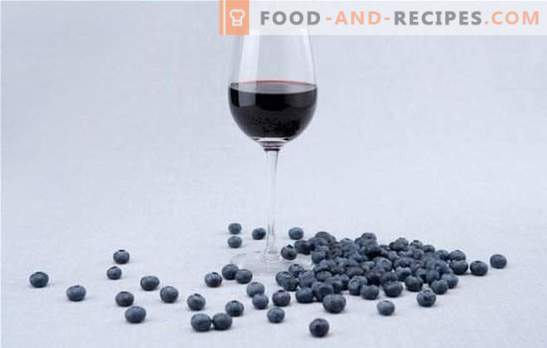
Homemade wines have a special place in the making of wines, and this is where industrial winemaking originated.
Wine can be made from any fruit, having in its composition sugar and the necessary set of acids, so for its production at different times and in different parts of the world were used fruits growing in a particular climatic zone. Countries with a warm climate and a sufficient number of sunny days, nature has set aside a place for the growth of the sweetest fruits. In these areas, viticulture originated and developed. But the temperate and even northern latitudes also have their wealth. Although the berries in these places ripen in more severe conditions, their value from this is no less high.
No one wants to even imagine the fruit and berry diversity of our planet without blueberries, unique in its biochemical properties of the berries, which is useful not only fruits but also flowers, leaves and even roots. In an area where blueberries grow, people use its magical properties all year round. It is dried, frozen, boiled jams and compotes, marinated, sauces are prepared, it is used instead of tea, dumplings are molded with it, baked cakes, and added to pickles.
But even from blueberries you can make wine, which in many ways will not be inferior in quality to wines from red grapes growing somewhere far from blueberries, on the southern slopes and plains.
Blueberry Wine - Basic Technological Principles
The stages of making fruit wines differ only slightly from the domestic and production technology of grape wines, which is a traditional crop for winemaking:
- Collection and preparation of wine raw materials;
- Getting juice or pulp;
- Wort preparation;
- Introduction of yeast;
- Fermentation;
- Removal from sediment and clarification of young wines;
- Wine transfusion and ripening;
- Sweetening and ripening;
- Repeated removal from sediment;
- Filling and storage.
For grape wine, it is not necessary to flavor the juice, as for other wine materials at the stage of preparing the wort.
What is it and why do you need to regulate the composition of fruit juice? To get the wine is important a certain content of sugar and acid in the juice. If in grapes these components are in the required amount in their natural form, then in most fruits and berries, the ratio of acid and sugar to obtain a wine must must be balanced.
There is a certain rate of acidity and sugar content of the wort. The total amount of acids contained in various berries should not exceed 0.7-0.8% per unit volume. There are also upper and lower limits of this norm, respectively, 0.6 and 1.2%. Exceeding the specified value can cause wort (and future wine) contamination by mold or vinegar bacteria, not to mention the unpleasant taste of the drink. The deviation in the direction of reducing acidity below the marginal rate also makes the wine weak, makes storage difficult, during which the wine will also be subject to attacks by unwanted microorganisms.
Blueberries contain an average of 0.8-1.45% of acid, including tannic acid, which is also important for wine. This acidity is almost ideal for making blueberry wine. True, at home it is difficult to determine the exact value of this indicator and, most likely, it is necessary to determine it in an organoleptic way.
But these figures may fail. In this case, it is possible to resort to arithmetic calculations for a more accurate determination of the acid, which will be correct from a technological point of view. However, taking into account that depending on the season, the number of sunny days of a berry may be more acidic than indicated in the upper limit of the norm, and if you take the lower indicator as a basis, the acidity of the juice may be lower than 0.6%, which is not acceptable. In this case, to avoid mistakes, it is better to resort to this method of determining acidity using litmus paper, sodium hydroxide solution (5.97%) in distilled water, glass tubes with a scale of division, which allows to determine the volume of liquid (juice and solution) and glass for transfusion juice. Remember that 0.1% acid is neutralized in 1 ml of alkali. Litmus paper in alkaline solution is painted blue, and in acidic - in red. Further - everything is simple, and there will be no mistakes in making up the wort from blueberry juice. Just in case, write down in a notebook that 700 ml of pure juice can be obtained from 1 kg of blueberries.
If the issue of obtaining wine from natural juice is not fundamental, then just add some water. At the same time, remember that for a blueberry wine the addition of water to the juice should not exceed 50%, otherwise the wine will turn brown and its taste will also be hopelessly spoiled. If you still want to get a natural wine, then alkalify some of the juice to remove the acid from it, and then combine it with sour juice.
We now turn to the question of the role of sugar in wine. It is the basis of taste, the energy for yeast microorganisms and the alcoholism of wine.
20 grams of granulated sugar increases the alcohol content by one degree (per 1 liter of wine). For example, the natural sugar content of bilberries 5.8% per 1 liter of juice. Here we take into account that the juice should already be balanced in acid content. To prepare a wine with a strength of 12%, you need to add 6.2% sugar for each liter of wort. For sweet dessert blueberry wine (14–16%) or strong dessert wine (17–20% and above), the amount of sugar increases, respectively.
Sugar is added to the wine at the end of fermentation and after removal from the sediment to improve the taste, after which the wine is left to age at a lower temperature than the fermentation temperature.
Sometimes, in the home winemaking, ferment is used to ferment wine or wild yeast. In the case of blueberry wine, use only a pure culture of wine yeast grown under special conditions.
Blueberry wine requires only high-quality yeast, and they need to create ideal conditions for processing sugar into alcohol, which means that, like all living organisms, yeast needs nourishment, which for yeast is not sugar, but, oddly enough, ammonia which requires 0.2-0.4 g per 1 l of wine mash.
Of course, speaking of wine yeast and fermentation of wine, it is necessary to emphasize that the temperature regime is an important condition. Therefore, remember that the lower temperature threshold for fermentation of any wine is +14 degrees. At this temperature, fermentation is suspended. At +25 degrees, the yeast becomes hot, and they work sluggishly. And blueberry wine already cooks longer, than other berry wines. These two numbers must be remembered so as not to spoil the wine. You can start the fermentation again and correct the wort, but the wine will not be so canceled. The normal temperature is 18-22 degrees and the complete absence of sudden changes in temperature and drafts in the room where the bottle of future wine stands. The addition of tannic acid (tannin) is required only in the case of preparing strong, dessert and liqueur wines from blueberries.
Recipe 1. Table dry blueberry wine
Composition:
- Juice, bilberry (acid. 1.1%; sugar. 6.2%) 7.3 l
- Sugar 1.45 kg
- Water 1.9 L
- Salat of 4 g
- Wine yeast 3 g
Technology:
Berries must be bruised, remove overripe, using the press or other devices, squeeze the juice. Pour the remaining pulp with water, add sugar and, slightly warming up, stir the sugar until it is completely dissolved. The resulting juice of the second discharge is separated from the cake and combine with natural juice. Add ammonia, having previously dissolved it in a small volume of wort. In a pre-prepared sterile bottle (at least 12 liters) pour the wort, close the neck with a gauze pad for several hours, so that the yeast can breathe.
Stir the wort until bubbles appear on the surface, then replace the gauze pad with a water seal. Keep the bottle for normal fermentation at a temperature of 18-22 degrees. When the gas stops being released and out through the water gate tube, and the line of the precipitated sediment is clearly marked at the bottom of the bottle, transfer the wine to another container, carefully, without agitating the precipitated juice particles and fermented yeast. Do this with the help of a tube, according to the principle of communicating vessels. Wash the bottle, pasteurize it and dry. Pour wine into it through the funnel and place it in a cool place (+ 10-14 degrees) for aging. Wine should be completely clarified and become transparent. Re-remove it from the sediment. If desired, you can add sugar to improve the taste, re-pour the wine into a sterile bottle and withstand at least six months.
Recipe 2. Strong table blueberry wine
Composition:
- Sugar 1.9 kg
- Water 5.7 L
- Wine yeast 5 g
- Salat of 4 g
- Blueberry juice 8.25 l
Cooking:
Table strong wine made from blueberries is prepared as described in the previous recipe. After six months of exposure, pour the wine into bottles, filling them 8 cm below the neck, seal tightly and pasteurize in a saucepan with water heated to 60-70 degrees for 8-10 hours, preventing overheating. Cool without removing from the pan. Store in the basement. Be sure to check the tightness of the closure.
Recipe 3. Strong blueberry wine using port wine technology
Composition:
- Juice 8 l
- Tartaric acid 2 g
- Sugar 3.2 kg
- Salat of 5 g
- Tannin 30g
- Cognac 40% (brandy) 1.6 l
Cooking:
Prepare the wort by combining all the ingredients except tannin and cognac. At the beginning of the quiet fermentation, interrupt the process by removing the wine from the sediment and filtering it very carefully. Add tannin and brandy to completely stop the fermentation. Pour the wine until the sediment is completely removed. At the same time maintain the bottle in the basement. Perfect port wine matures in oak barrels. Therefore, put a canvas bag filled with oak bark in the bottle. Bottle and seal.
Recipe 4. Muscat Blueberry Dessert Wine
Composition:
- Sugar 3.9 kg
- Muscat, ground 40 g
- Tartaric acid 6 g
- Blueberry juice 7.6 l
- Ammonium salts 4 g
- Tannic acid 30 g
Cooking Technology:
Prepared ripe blueberries mash, pour half the required amount of sugar. After the start of fermentation, squeeze out the fermented juice. Add ammonium powder, tartaric acid and ground nutmeg to it. Pour the wort into the bottle and close it with the fermenting dowel. At the end of fermentation, not later than two weeks remove the wine from the sediment and add the remaining sugar. Soak the wine for at least six months in a cool place, periodically removing it from the sediment, to full transparency.
Recipe 5. Blueberry liqueur wine
Ingredients:
- Bilberry juice 6.2 l
- Raisin, white 2.1 kg
- Sugar 3.6 kg
- Brandy 1.5 L
Cooking Technology:
Crush the raisins with a blender. Heat the juice to 25 degrees, pour into it half the cooked sugar and crushed raisins. Mix thoroughly to dissolve the sugar. Pour the wort into the fermentation bottle, but install the water trap only after the fermentation begins. Be patient, because the fermentation in the manufacture of liqueur wines takes 1.5 longer than for ordinary wines. After the phase of rapid fermentation, when gas bubbles are emitted most actively, remove the closure, pour the wort into another bowl through a sieve to remove the raisin particles. Pour it again into the bottle and put the stopper. Repeat this operation for a month 5 times, after five days, to stop the process of sugar processing by yeast. After the fifth transfusion, add the second part of the sugar and the prepared tincture to the wine. Leave it in the bottle by placing it in a cool place for clarification. Do not forget to regularly, once every two weeks, check the liqueur wine and remove from the sediment, if necessary. Bottled only after full clarification, achieving maximum transparency.
Preparation of liqueur wine tincture:
Place the pulp after squeezing the juice in a separate bottle and fill it with brandy. Insist until the end of the fermentation of wine, after squeeze the thick of the pressing and pass the tincture through a tight filter.
Blueberry Wine - Tricks and Tips
- Blueberries, like wine materials, combine well with fruits that have low acidity, such as pears, mulberries, cloudberries, oranges, cherries, cherries, and strawberries. Compiling blended wort will expand the range of homemade blueberry wines. The ratios of fruit juices can be different, but if you want the taste of some particular fruits to prevail in the wine, then to make the wort, you need these fruits to be 1/2 part, and the remaining fruit juices should be added proportionally to their number, divided into equal parts. It should be borne in mind that, for example, oranges or strawberries have a rather rich aroma that can drown out the other components of the wort. Therefore, using fruit components with a bright aroma, you need to add them in a smaller volume so that the taste of the wine is well balanced.
- Blueberry wine is prepared for a long time. Therefore, for the preparation of wort and normal fermentation, one should use “cultural” wine yeast, rather than wild, so that the wort can complete fermentation without being infected by other bacteria, whose presence can destroy the wine.
- In terms of its biochemical qualities, blueberries are close to red muscat grapes. Therefore, it will be quite fair to believe that exposure to sunlight is harmful for blueberry wine, which will turn the wine into a brown liquid, destroying the beneficial enzymes in it.

